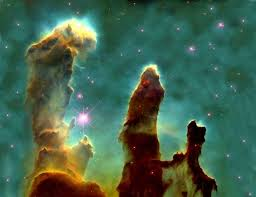Our constellations are named after Greek and Roman gods and a whole superstitious astrology had derived, based on the position of the stars in the visible sky at the date and time of your birth. How lucky we are to have physicists like Professor Brian Cox to throw open the curtains and explain things in comprehensible language. I personally have been delighted by his books and documentaries. He has helped to dispel my childhood fears about, all that nothing that can never end: The stuff of nightmares for an intelligent child.
The Hubble telescope has brought us a new kind of art-photography, capturing our galaxy in high definition, delighting us with the limitless scope of color and the immensity of the Pillars of the Universe, three pillars in the Eagle Nebula, formed over millions of years from the radiation and dust from around twenty or more huge stars.
Gallileo was the first human being to turn his telescope to the night sky and look at Jupiter. He observed four of Jupiter's moons and in doing so, confirmed Copernicus' revolutionary view of the solar system. Here was direct evidence of other worlds orbiting a planet, unequivocally breaking the divine symmetry of the Earth-centred cosmos for good and challenging what was for many a deeply held belief.
We continue to learn. Mariner 10, launched by NASA in 1973 flew past Mercury and managed to map 45% of the surface with what would now be classed as low-resolution equipment. The Messenger space probe has proved far more successful, sending back spectacular images of the surface.
Voyagers 1 and 2 were launched in 1977 with the mission to visit all four of the Solar System's gas giants - Jupiter, Saturn, Uranus and Neptune. Normally the journey would have taken thirty years but at the time of launch the planets were uniquely aligned, allowing the probes to complete their grand tour in less than twelve years. Voyager 1 is still reporting back and it's batteries are expected to function until 2025 and will be the first man-made object to leave our solar system.
What a wonderful world.

Heliocentricity
I am speeding round the sun at 30kmph per sec, No wonder it's so hard for me to write. I'm lapping Mars in retrograde: He's slow and I don't see him every night.
There is lots of slower traffic sitting in the outside lanes. I see them in the darkness - I even know their names. I marvel at them every time I pass, Travelling in celestial clockwork, How them seem belies their mass.
I am pillion on a planet, designed to such specifics, It keeps me fed and watered and in comfort for the ride, Tilted at the perfect pitch towards a mighty power, That seasonally warms and then warms the other side.
For aeons man believed the earth was central to it all. That theory served the purpose of religion after all. But when he saw Mars charge to sky Then loop into reverse, Copernicus declared us Heliocentric. The Pa-al frock was hoisted: They said he was eccentric, But science was born to lead us into light.
And so we race around the sun, As other planets do. That's why we're here, that's why we are, The earth and me and you.
Thank you for reading. Adele
Email ThisBlogThis!Share to TwitterShare to Facebook
Reactions:
